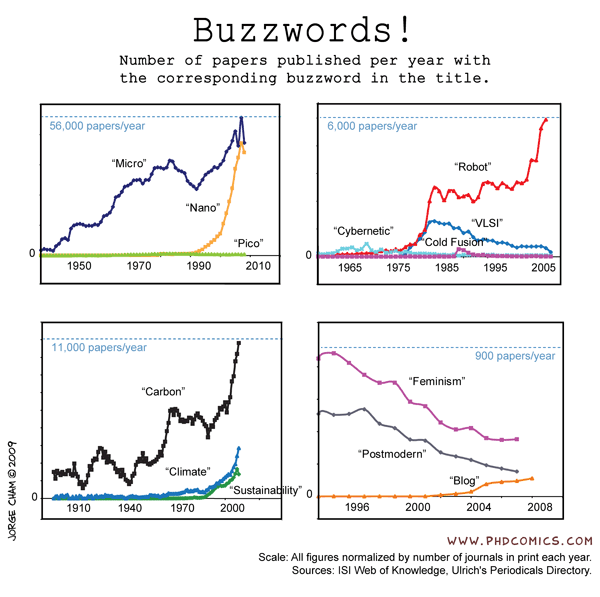Original source: phdcomics (which is a page I strongly recommend!)
I wonder what are the figures for "Compact Model", "Physical Model", "Analytical model", etc...
Nov 18, 2009
Nov 17, 2009
EUROSOI 2010
Sixth Workshop of the Thematic Network on Silicon on Insulator technology, devices and circuits
Grenoble, France, 25-27 January, 2010
Grenoble, France, 25-27 January, 2010
- Keynote Talks
- SOI- the next five years: The critical role that SOI will play in the semiconductor ecosystem and how it will happen – H. Mendez (SOI Consortium)
- Germanium Integration on Silicon for High Performance FETs and Optical Interconnects – K. Saraswat (Stanford University)
- Training Course
- 3D integration – N. Sillon (CEA-LETI)
- Electrical characterisation of SOI nanodevices – G. Ghibaudo (IMEP)
- Piezoelectrical technology on SOI (RF Filter) – S. Ballandras (CNRS)
- III-V nanoelectronic on insulator – S. Bollaert (CNRS)
- SOI technologies and circuits – J. Hoentschel (Global Foundries)
Nov 15, 2009
Call for Papers: ICGCS 2010
Global warming, climate change, and sustainability have profound impacts on our lives. The grand challenge faced by circuits and systems communities is to design green electronic devices and systems that consume less energy, thus lead to the reduction of global CO2 emission. The annual International Conference on Green Circuits and System (ICGCS) is our response to this grand challenge. ICGCS aims to address issues in climate change and limited suppliers and become a major international forum for researchers and engineers to exchange their latest findings in technologies related to green circuits and systems. ICGCS is a meeting place for scholars, scientists, educators, students, engineers, entrepreneurs, and managers from different disciplinarians to foster collaborations and to solve complex read world problems. It covers a wide range of topics including, but not limited to, the followings:
The deadline for submission of Papers is on February 22, 2010. For more details, please visit: http://www.icgcs.org. We welcome you to contribute your work(s) to ICGCS2010 and hope to see you in Shanghai.
Contact: Yong Lian and Tor S. Lande; ICGCS 2010 Technical Program Chairs
- Green Transistors and Devices
- Low Power Low Voltage Techniques for Analog, Mixed-Signal, Digital Circuits
- Sub-threshold Circuit Design
- Energy Efficient Analog Signal Processing Techniques
- Computationally Efficient Digital Signal Processing Techniques
- Signal Processing for Communications
- Visual Signal Processing Techniques and Multimedia Systems
- Optimization Techniques
- Self-Powered Circuits and Systems
- Adaptive and Reconfigurable Circuits and Systems
- Scalable and Power Aware Systems
- Energy Harvesting
- Energy and Power Management
- Green Power Electronic Circuits and Systems
- Renewable Energy
- MEMS and Sensors for Energy Management
- Environmental Sensing, Control and Protection
- Circuits and Systems Technologies for Recycling and Pollution Control
- Emerging Technologies for Green Circuits and Systems
The deadline for submission of Papers is on February 22, 2010. For more details, please visit: http://www.icgcs.org. We welcome you to contribute your work(s) to ICGCS2010 and hope to see you in Shanghai.
Contact: Yong Lian and Tor S. Lande; ICGCS 2010 Technical Program Chairs
Nov 13, 2009
Open, One year post doc position for development of HV transistor SPICE models
Education/Experience:
Senior Manager Process and Device Characterization - Modeling
austriamicrosystems AG
Operations - Process Developments
Schloss Premstaetten
8141, Unterpremstaetten, Austria
Tel: +43 3136 500 5487
Fax: +43 3136 500 5755
- PhD or Master/Dipl. Ing. in Physics or Electronic Engineering
- Experience in SPICE modeling (e.g. BSIM, EKV, PSP, HiSIM)
- Unterpremstaetten/Graz , Austria
- Development of HV transistor SPICE models
- Parameter extraction and measurements for SPICE models
- Project management within the COMON project
- Writing documents and deliverables
Senior Manager Process and Device Characterization - Modeling
austriamicrosystems AG
Operations - Process Developments
Schloss Premstaetten
8141, Unterpremstaetten, Austria
Tel: +43 3136 500 5487
Fax: +43 3136 500 5755
A CAD-compatible closed form approximation for the inversion charge areal density in double-gate MOSFETs
Venkatnarayan Hariharan, Juzer Vasi, V. Ramgopal Rao; Solid-State Electronics, Volume 53, Issue 2, February 2009, Pages 218-224
Abstract: In developing the drain current model of a symmetrically driven, undoped (or lightly doped) symmetric double-gate MOSFET (SDGFET), one encounters a transcendental equation relating the value of an intermediate variable β (which is related to the inversion charge areal density and also surface-potential) to the gate and drain voltages; as a result, it doesn’t have a closed form solution. From a compact modeling perspective, it is desirable to have closed form expressions in order to implement them in a circuit simulator. In this paper, we present an accurate closed form approximation for the inversion charge areal density, based on the Lambert-W function. We benchmark our approximation against other existing approximations and show that our approximation is computationally the most efficient and numerically the most robust, at a reduced but acceptable accuracy. Hence, it is suitable for use in implementing inversion charge based compact models.
DOI: 10.1016/j.sse.2008.11.006
Abstract: In developing the drain current model of a symmetrically driven, undoped (or lightly doped) symmetric double-gate MOSFET (SDGFET), one encounters a transcendental equation relating the value of an intermediate variable β (which is related to the inversion charge areal density and also surface-potential) to the gate and drain voltages; as a result, it doesn’t have a closed form solution. From a compact modeling perspective, it is desirable to have closed form expressions in order to implement them in a circuit simulator. In this paper, we present an accurate closed form approximation for the inversion charge areal density, based on the Lambert-W function. We benchmark our approximation against other existing approximations and show that our approximation is computationally the most efficient and numerically the most robust, at a reduced but acceptable accuracy. Hence, it is suitable for use in implementing inversion charge based compact models.
DOI: 10.1016/j.sse.2008.11.006
Subscribe to:
Comments (Atom)

